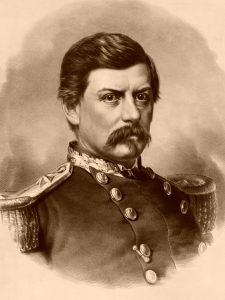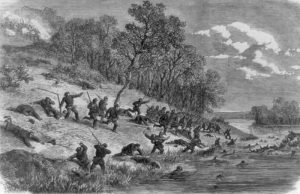The Union defeat at the First Battle of Manassas shocked the North, and a new sense of grim determination swept the United States as military and civilians alike realized that they would need to invest significant money and manpower to win a protracted, bloody war. Major General George B. McClellan was summoned east in August to command the newly forming Army of the Potomac, which would become the principal army of the Eastern Theater. As a former railroad executive, he possessed outstanding organizational skills well-suited to training and administration tasks. McClellan’s Operations in Northern Virginia occurred from October to December 1861. By November 1, he had maneuvered around Winfield Scott and was named general-in-chief of all the Union armies.
Ball’s Bluff (October 21, 1861) – Also known as the Battle of Harrison’s Island or the Battle of Leesburg, this battle was fought in Loudoun County. While a minor engagement compared with the battles that would occur in years to follow, this was the second largest battle of the Eastern Theater in 1861. On the evening of October 20, 1861, Brigadier General Charles Stone sent a small scouting party across the Potomac River in Leesburg, Virginia. In the darkness of night, the inexperienced head of the scouting party, Captain Chase Philbrick, mistook a tree line for a line of tents and returned to Stone with a report of an unguarded camp.
Stone decided to take advantage of this opportunity with a nighttime raid and sent about 300 men under Colonel Charles Devens back across the river. When Devens discovered that the line of trees was not a campsite, he decided to stay and wait for reinforcements to attempt to reach Leesburg. As dawn broke on the 21st, Mississippians under Colonel Nathan “Shanks” Evans encountered Devens’ advanced units, and a sharp skirmish began. General Stone sent Colonel Edward Baker, a U.S. Senator, to command the field and assess the situation. Baker immediately began gathering troops to reinforce the men on the Virginia side of the river. When support finally arrived four hours later, communications between the various Union commanders had been inefficient and often misunderstood.
Lightly schooled in military tactics, Baker led his 1,700-member brigade across the Potomac River, up the steep ridge known as Ball’s Bluff, and into the range of waiting enemy guns. Led by Brigadier General Nathan G. Evans, the Confederates drove the Federals over the 70-foot cliffs to the rock-studded river below. More than 1,000 Union troops were killed, wounded, or captured, including Colonel Edward Baker’s death. This disaster led directly to creating the toughest congressional investigating committee in history — the Joint Committee on the Conduct of the War. Of the Union troops engaged, there were 1,070 casualties, 700 of which were captured. Of the 1,600 Confederate soldiers involved, there were an estimated 149 casualties.
Bog Wallow Ambush (December 4, 1861) – After the Battle of Ball’s Bluff on October 21, 1861, significant offensive action was halted in the Eastern Theater, as both armies went into winter quarters. Small detachments were occasionally sent out to probe the enemy’s position and to obtain forage, and a small shootout occurred on November 5. Intending to retaliate against the Confederate forces for attacks on Union pickets, Union troops led by Captain J. Fred set up an ambush for the Confederate force on the Braddock Road in Fairfax County, Virginia. The action resulted in a Union victory with four Union casualties and five Confederates.
Dranesville (December 20, 1861) – Taking place in Fairfax County, Confederate Brigadier General J.E.B Stuart led a brigade-sized mixed force of cavalry, infantry, and artillery to protect a foraging expedition in the vicinity of Dranesville. Though significant offensive action had been halted in the Eastern Theater, small detachments were still sent out to probe the enemy’s position and obtain forage as both armies went into winter quarters. As General Stuart led his brigade, the Confederate troops encountered Union Brigadier General E.O.C. Ord and his troops advancing on the Georgetown Pike. Both sides deployed as more units arrived on the field, and a sharp firefight developed. Stuart withdrew in the mid-afternoon after ensuring that his wagons were safely in the rear. The Union victory resulted in 71 Federal casualties and 230 Confederate casualties.
Compiled and edited by Kathy Weiser-Alexander/Legends of America, updated October 2021.
Also See:
Sources:
Battlefields.org
National Park Service Battle Descriptions (no longer available online)
National Park Service Civil War


